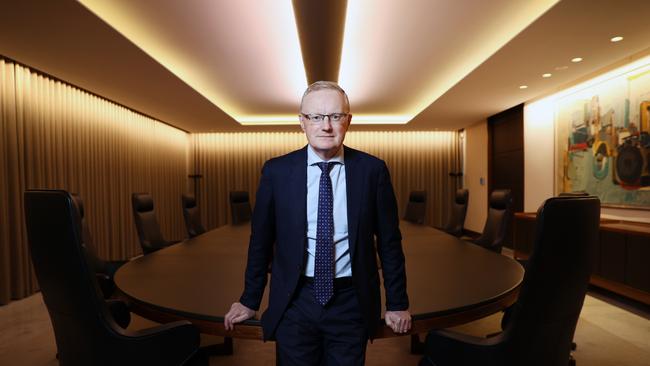Philip Lowe has a communications problem that needs fixing

Technically, Lowe is right: he has never explicitly said that official rates will not rise in 2022.
But try telling that to heavily indebted homeowners who bought at or near the top of the market, and find the wording of RBA monetary policy decisions somewhat dense and convoluted.
They will tell you that the odds of a rate rise in 2022 are impossibly high, and some of them might even repeat Lowe’s mantra that the cash rate is not likely to be lifted until late 2023 – or more likely 2024 – when inflation is sustainably in the RBA’s target range of 2-3 per cent.
Yet inflation is already in the prescribed band, a seemingly impenetrable cap on wages is starting to crack, and the futures market is pricing in not one but four rate increases this year.
Lowe called an end to bond purchases, or quantitative easing, in the RBA’s monetary policy decision on Tuesday, cautioning that this did not imply a near-term increase in rates.
However, the governor’s statement acknowledged that “faster-than-expected progress has been made towards the RBA’s goals, and further progress is likely”.
It’s quite possible that Lowe was warming up for the full wriggle, but felt constrained by the formula for communicating monetary policy decisions, which demands brevity.
Things might change on Wednesday, when he addresses the National Press Club on the topic of “The Year Ahead”.
Inevitably, he will be asked about the timing of the next rate rise if his speech doesn’t address the elephant in the room.
Perhaps the governor will concede there is at least a possibility that official rates will rise before the end of the year.
It would be one way of dealing with a problem of the RBA’s own making, which Peter Costello invoked on Tuesday as justification for a review of the central bank.
Presenting the Future Fund’s portfolio performance for the quarter to December 31, Costello said the RBA’s retreat from yield curve targeting represented a hit to the central bank’s credibility.
This followed the April 2024 bond yield surging through the RBA’s stated target last October.
Costello also said the 2-3 per cent inflation objective, which he introduced as treasurer in 1997, was “well worth having a look at”.
“It doesn’t necessarily mean you change it; you might have a look at it and come to the view that it’s still appropriate,” he said.
Independent economist Saul Eslake backs Costello’s call for an RBA review, which has also been supported by Josh Frydenberg and the Treasurer’s Labor shadow, Jim Chalmers.
Eslake says he’s not a critic of the RBA, believing it has been one of the nation’s better-performed institutions over the long term.
For Eslake, though, the central bank’s communications strategy should be part of the review.
“The commitment on rates by the RBA should not have been made,” the economist says. “I agree that the end of quantitative easing should not be seen, in and of itself, as a sign that rates will rise.
“But the fact that inflation in the fourth quarter of last year got to a level that the RBA said would not be reached until the fourth quarter of 2023 could be seen as a pointer to rising rates.”
One option, he says, would be to follow the policy of the US Federal Reserve, where the chairman holds a press conference after each policy meeting.
NAB gains favour
With the new year barely under way, National Australia Bank has emerged as the market’s favourite among the four major banks amid robust business credit trends.
The post-financial crisis housing boom created extraordinary value for shareholders in the nation’s biggest home lender, Commonwealth Bank, realising most of ex-ANZ chief executive Mike Smith’s prediction of two banking pillars (CBA and Westpac) and two stumps (NAB and ANZ).
While it’s too early to call a reversal of the cycle in favour of the business banking stumps, the portents are better than they have been for a long time.
Barrenjoey bank analyst Jon Mott said on Monday after the release of the Reserve Bank’s financial aggregates data for December that momentum in business lending was building “across the system”, spilling over into NAB’s heartland of small and medium-sized businesses.
Housing, on the other hand, remained strong but looked as though it had peaked.
“NAB has seen good momentum across most lending categories, winning share in business and housing,” Mott said. “Westpac is losing momentum.”
NAB’s housing portfolio was up 3.2 per cent for the December quarter, after it won market share in both the owner-occupier and investor segments. In business lending, it was up 4.3 per cent.
Westpac grew in line with the wider banking system in the owner-occupier category, but its investor book contracted 2.1 per cent.
ANZ continued to struggle in housing, with its portfolio flat over the month and the quarter, while CBA remained consistent, with its owner-occupier book expanding 2.5 per cent and the investor book up 2.7 per cent.
NAB is Mott’s top pick among the major banks, as it is for JPMorgan bank analyst Andrew Triggs, who said NAB was the best play for business lending growth, which continued to “surprise on the upside”.
Macquarie brackets NAB with CBA as the two banks likely to outperform this year.
gluyasr@theaustralian.com.au Twitter: @Gluyasr



Philip Lowe has a communications problem – he needs to find a way of wriggling out of a commitment that the Reserve Bank governor probably feels he never made.